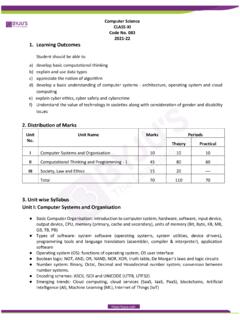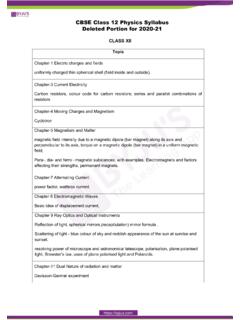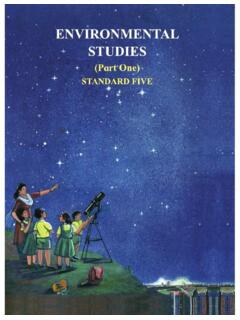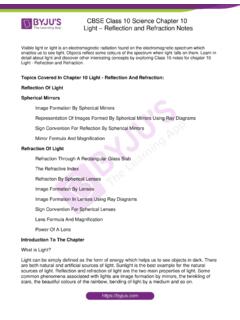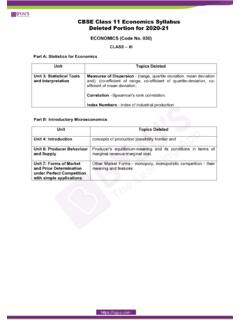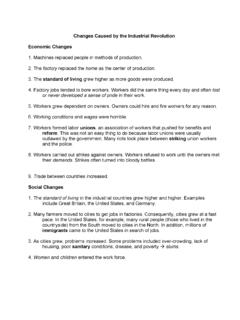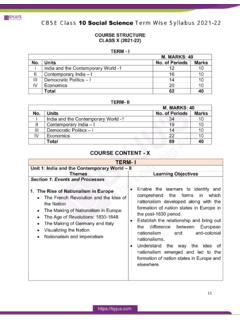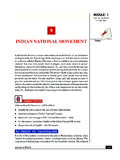Transcription of CBSE Class 10 Social Science Syllabus 2021-22
1 14 COURSE STRUCTURE Class X (2021- 22) Theory Paper Time: 3 Hrs. Max. Marks: 80 No. Units No. of Periods Marks I India and the Contemporary World II 60 20 II Contemporary India II 55 20 III Democratic Politics - II 50 20 IV Understanding Economic Development 50 20 Total 215 80 COURSE CONTENT Unit 1: India and the Contemporary World II 60 Periods Themes Learning Objectives Section 1: Events and Processes Rise of nationalism in Europe The French Revolution and the Idea ofthe Nation The Making of nationalism in Europe The Age of Revolutions: 1830-1848 The Making of Germany and Italy Visualizing the Nation nationalism and in India The First World War, Khilafat and Non -Cooperation Differing Strands within the Movement Towards Civil Disobedience The Sense of Collective Belonging Enable the learners to identify andcomprehend the forms in whichnationalism developed along withthe formation of nation states inEurope in the post-1830 period.
2 Establish the relationship andbring out the difference betweenEuropean nationalism and anti-colonial nationalisms. Understand the way the idea ofnationalism emerged and led to theformation of nation states inEurope and elsewhere. Recognize the characteristics ofIndian nationalism through a casestudy of Non-Cooperation and CivilDisobedience Movement. Analyze the nature of the diversesocial movements of the time. Familiarize with the writings andideals of different political groupsand Class 10 Social Science Syllabus 2021-2215 Section 2: Livelihoods, Economies and Societies: Any one theme of the following: 3. The Making of a Global World The Pre-modern world The Nineteenth Century (1815-1914) The Inter war Economy Rebuilding a World Economy: The Post-War Era 4.
3 The Age of Industrialization Before the Industrial Revolution Hand Labour and Steam Power Industrialization in the colonies Factories Come Up The Peculiarities of Industrial Growth Market for Goods Section 3: Everyday Life, Culture and Politics 5. Print Culture and the Modern World The First Printed Books Print Comes to Europe The Print Revolution and its Impact The Reading Mania The Nineteenth Century India and the World of Print Religious Reform and Public Debates New Forms of Publication Print and Censorship Appreciate the ideas promoting Pan Indian belongingness. Show that globalization has a long history and point to the shifts within the process. Analyze the implication of globalization for local economies.
4 Discuss how globalization is experienced differently by different Social groups. Familiarize with the Pro- to-Industrial phase and Early factory system. Familiarize with the process of industrialization and its impact on labour Class . Enable them to understand industrialization in the colonies with reference to Textile industries. Identify the link between print culture and the circulation of ideas. Familiarize with pictures, cartoons, extracts from propaganda literature and newspaper debates on important events and issues in the past. Understand that forms of writing have a specific history, and that they reflect historical changes within society and shape the forces of change.
5 16 Unit 2: Contemporary India II 55 Periods Themes Learning Objectives 1. Resources and Development Types of Resources Development of Resources Resource Planning in India Land Resources Land Utilization Land Use Pattern in India Land Degradation and Conservation Measures Soil as a Resource Classification of Soils Soil Erosion and Soil Conservation 2. Forest and Wildlife Biodiversity or Biological Diversity Flora and Fauna in India Vanishing Forests Asiatic Cheetah: Where did they go? The Himalayan Yew in trouble Conservation of forest and wildlife in India Project Tiger Types and distribution of forests and wildlife resources Community and Conservation Note: The chapter Forest and Wildlife to be assessed in the Periodic Tests only and will not be evaluated in Board Examination.
6 3. Water Resources Water Scarcity and The Need for Water Conservation and Management Multi-Purpose River Projects and Integrated Water Resources Management Rainwater Harvesting Understand the value of resources and the need for their judicious utilization and conservation. Understand the importance of biodiversity with regard to flora and fauna in India. Analyse the importance of conservation of forests and wildlife. Comprehend the importance of water as a resource as well as develop awareness towards its judicious use and conservation. 17 Note: The theoretical aspect of chapter Water Resources to be assessed in the Periodic Tests only and will not be evaluated in Board Examination.
7 However, the map items of this chapter as given in the Map List will be evaluated in Board Examination. 4. Agriculture Types of farming Cropping Pattern Major Crops Technological and Institutional Reforms Impact of Globalization on Agriculture 5. Minerals and Energy Resources What is a mineral? Mode of occurrence of Minerals Ferrons and Non-Ferrons Minerals Non-Metallic Minerals Rock Minerals Conservation of Minerals Energy Resources o Conventional and Non-Conventional o Conservation of Energy Resources 6. Manufacturing Industries Importance of manufacturing Contribution of Industry to National Economy Industrial Location Classification of Industries Explain the importance of agriculture in national economy.
8 Identify various types of farming and discuss the various farming methods; describe the spatial distribution of major crops as well as understand the relationship between rainfall regimes and cropping pattern. Explain various government policies for institutional as well as technological reforms since independence. Identify different types of minerals and energy resources and places of their availability Feel the need for their judicious utilization Bring out the importance of industries in the national economy as well as understand the regional disparities which resulted due to concentration of industries in some areas. 18 Spatial distribution Industrial pollution and environmental degradation Control of Environmental Degradation 7.
9 Life Lines of National Economy Transport Roadways, Railways, Pipelines, Waterways, Airways Communication International Trade Tourism as a Trade Discuss the need for a planned industrial development and debate over the role of government towards sustainable development. Explain the importance of transport and communication in the ever-shrinking world. Understand the role of trade and tourism in the economic development of a country. Unit 3: Democratic Politics II 50 Periods Themes Learning Objectives 1. Power Sharing Case Studies of Belgium and Sri Lanka Why power sharing is desirable? Forms of Power Sharing 2. Federalism What is Federalism?
10 What make India a Federal Country? How is Federalism practiced? Decentralization in India 3. Democracy and Diversity Case Studies of Mexico Differences, similarities and divisions Politics of Social divisions Note: The chapter Democracy and Diversity to be assessed in the Periodic Tests only and will not be evaluated in Board Examination. 4. Gender, Religion and Caste Gender and Politics Religion, Communalism and Politics Familiarize with the centrality of power sharing in a democracy. Understand the working of spatial and Social power sharing mechanisms. Analyse federal provisions and institutions. Explain decentralization in rural and urban areas. Analyse the relationship between Social cleavages and political competition with reference to Indian situation.
